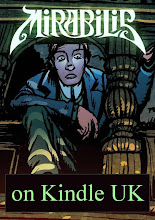 More storytelling tips today. But if you're not into the writing, don't fret - we'll be back with more luscious artwork later in the week.
More storytelling tips today. But if you're not into the writing, don't fret - we'll be back with more luscious artwork later in the week.When you're getting to the climax of a story, simply piling on more and more difficulties for your hero won't do. The audience sees a string of things that have to be dealt with and they project forward: “Once the hero has done A, found B, discovered C, it’s all going to be sorted.” So you need to throw in something completely from left field - a development that takes the reader or viewer by surprise: “Whoa, I didn’t foresee that at all!”
See, a storyteller is like a hypnotist or a con man. Shock is one of the best tricks for stunning your victim. I mean reader.
Here's an example from the movie of My Favorite Martian. Tim has to prevent the TV broadcast of a video of Uncle Martin which would prove the existence of aliens on Earth. Meanwhile Martin himself is going to pieces - literally - and his spaceship (which is counting down to self-destruct) has been reduced in size with Tim’s girlfriend inside and left in the garage, where the neighbour picks it up for a jumble sale. With a bit of fast-paced rompy action, all these problems are neatly fixed. They get the video, Martin is reassembled, and they catch up to the neighbour’s car and retrieve the “toy” spaceship. Whew! Exactly what we expected. But then, just at the moment of triumph, the government agents who were chasing them earlier turn up and zap Martin and Tim with a tranquilliser gun, and take them off to a remote army research base. Now we have no idea what’s going to happen next. The stuff we foresaw all got resolved; this is a new development we didn't see coming. And the story shifts into high gear as a result.
That's how it works on the overall plot level - the "break into three" as Blake Snyder puts it. But stories are fractal, and the same principle applies within one scene. In James Saxon's book Red Chamber, the hero, who is wanted by the police, has to sneak on board a Tube train at Sloane Square. The writing team's initial plan was for him to climb over the wall (the Tube line is open to the air at Sloane Square) but of course that on its own wouldn’t strike the reader as much of a challenge. So the hero climbs the wall from the street, but it's a big drop to the platform on the other side, and he has to get down by edging along a narrow iron pipe to a point where he can jump. On top of that it’s snowing, so not only is the pipe treacherous with ice, but he has to be careful not to dislodge snow so that the police look up. Then, to stay out of sight, he jumps onto the roof of a carriage, intending to swing down into the carriage just as the doors are closing...
But all of that stuff is just the sleight of hand to set us up for the real twist in the scene. Getting onto the Tube train roof calls for nerve and athleticism, and is undoubtedly all quite difficult without spider powers, but it's still only a “skill roll”. The reader knows that the writer can just decide to have the hero succeed. What we need is to see the hero come up with a solution to an unexpected problem, preferably under extreme pressure where we can’t imagine being able to do it ourselves in the time available. And that’s what happens next. There’s a policeman right there on the platform, so the hero can’t get inside the carriage after all. The doors close. Okay, he thinks, I’ll ride on the roof to the next station. So he (and we) start to relax… too soon! Because he now sees there is only about a foot’s clearance on the tunnel. Scrabbling back, he falls between two carriages and holds onto the “bellows” between the carriages with his shoes almost touching the tracks. Then at the next station he climbs onto the platform and makes his getaway. And boy, do we feel he’s earned it.

























No comments:
Post a Comment